Testing The World’s Best APUs: Desktop AMD Ryzen 4750G, 4650G and 4350G
by Dr. Ian Cutress on December 16, 2020 10:30 AM ESTCPU Benchmarks: Real World
All of our benchmark results can also be found in our benchmark engine, Bench.
Agisoft Photoscan 1.3.3: link
The concept of Photoscan is about translating many 2D images into a 3D model - so the more detailed the images, and the more you have, the better the final 3D model in both spatial accuracy and texturing accuracy. The algorithm has four stages, with some parts of the stages being single-threaded and others multi-threaded, along with some cache/memory dependency in there as well. For some of the more variable threaded workload, features such as Speed Shift and XFR will be able to take advantage of CPU stalls or downtime, giving sizeable speedups on newer microarchitectures.
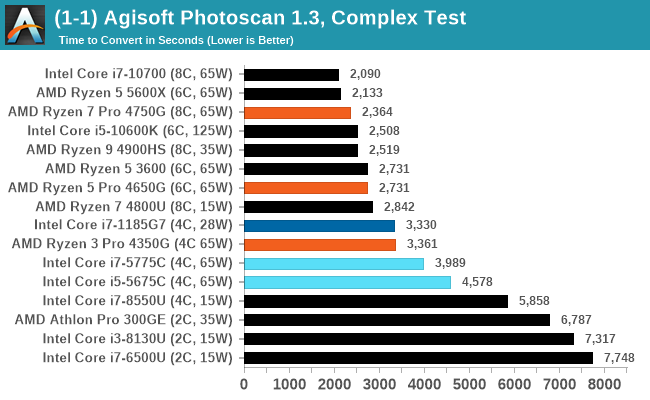
NAMD 2.13 (ApoA1): Molecular Dynamics
One of the popular science fields is modeling the dynamics of proteins. By looking at how the energy of active sites within a large protein structure over time, scientists behind the research can calculate required activation energies for potential interactions. This becomes very important in drug discovery. Molecular dynamics also plays a large role in protein folding, and in understanding what happens when proteins misfold, and what can be done to prevent it. NAMD, or Nanoscale Molecular Dynamics, has already been used in extensive Coronavirus research on the Frontier supercomputer. Typical simulations using the package are measured in how many nanoseconds per day can be calculated with the given hardware, and the ApoA1 protein (92,224 atoms) has been the standard model for molecular dynamics simulation.
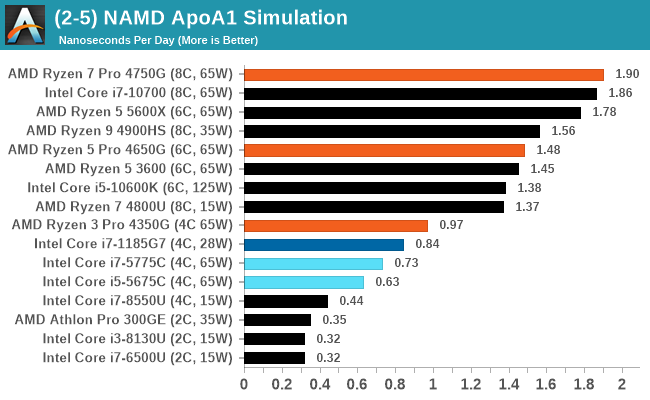
Blender 2.83 LTS: Link
One of the popular tools for rendering is Blender, with it being a public open source project that anyone in the animation industry can get involved in. This extends to conferences, use in films and VR, with a dedicated Blender Institute, and everything you might expect from a professional software package (except perhaps a professional grade support package). With it being open-source, studios can customize it in as many ways as they need to get the results they require. It ends up being a big optimization target for both Intel and AMD in this regard.
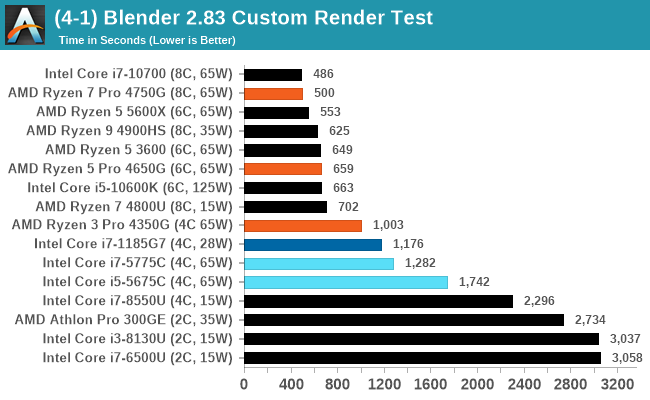
Corona 1.3: Link
Corona is billed as a popular high-performance photorealistic rendering engine for 3ds Max, with development for Cinema 4D support as well. In order to promote the software, the developers produced a downloadable benchmark on the 1.3 version of the software, with a ray-traced scene involving a military vehicle and a lot of foliage.
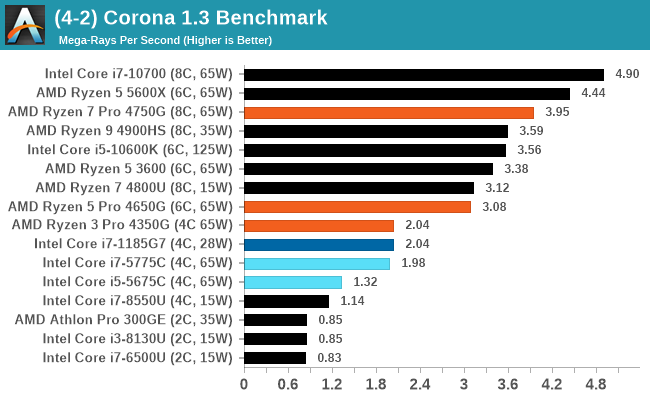
POV-Ray 3.7.1: Link
A long time benchmark staple, POV-Ray is another rendering program that is well known to load up every single thread in a system, regardless of cache and memory levels. After a long period of POV-Ray 3.7 being the latest official release, when AMD launched Ryzen the POV-Ray codebase suddenly saw a range of activity from both AMD and Intel, knowing that the software (with the built-in benchmark) would be an optimization tool for the hardware.
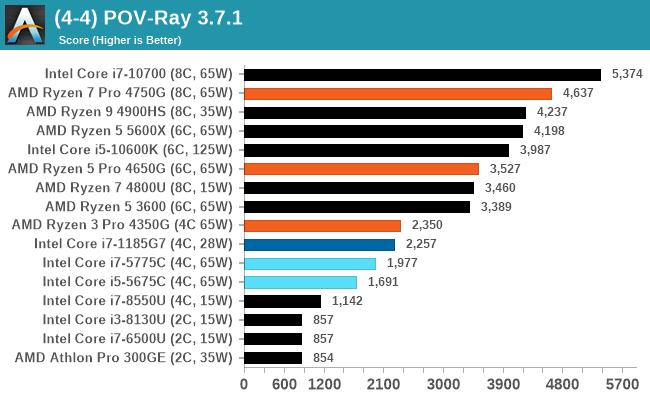
V-Ray: Link
We have a couple of renderers and ray tracers in our suite already, however V-Ray’s benchmark came through for a requested benchmark enough for us to roll it in. Built by ChaosGroup, V-Ray is a 3D rendering package compatible with a number of popular commercial imaging applications, such as 3ds Max, Maya, Undreal, Cinema 4D, and Blender.
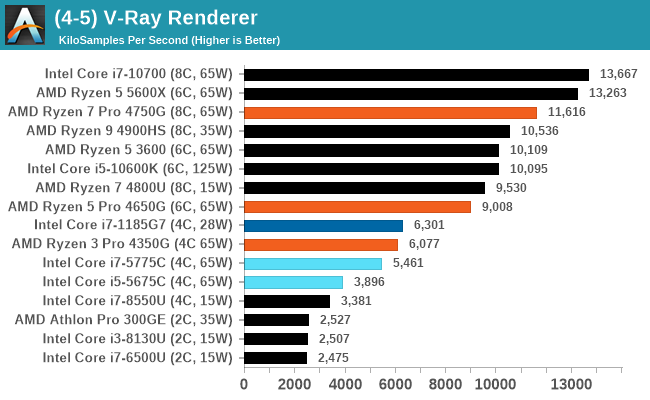
HandBrake 1.32: Link
Handbrake is a favored tool for transcoding, with the later versions using copious amounts of newer APIs to take advantage of co-processors, like GPUs. It is available on Windows via an interface or can be accessed through the command-line, with the latter making our testing easier, with a redirection operator for the console output. We take the compiled version of this 16-minute YouTube video about Russian CPUs at 1080p30 h264 and convert into a 480p30 ‘Discord’ format.
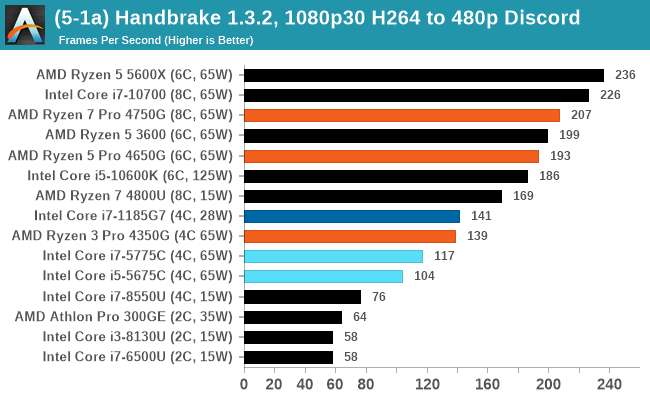
7-Zip 1900: Link
The first compression benchmark tool we use is the open-source 7-zip, which typically offers good scaling across multiple cores. 7-zip is the compression tool most cited by readers as one they would rather see benchmarks on, and the program includes a built-in benchmark tool for both compression and decompression.
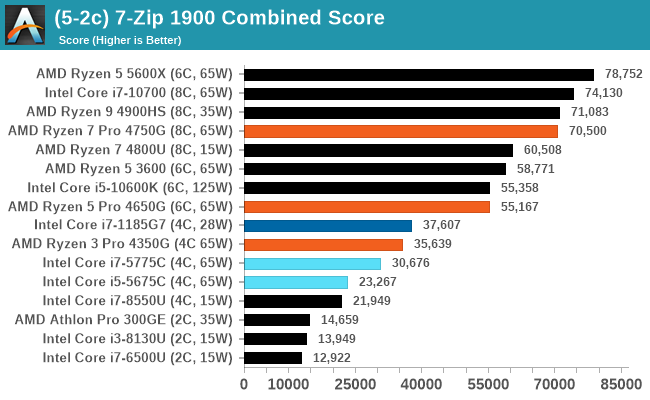
AES Encoding
Algorithms using AES coding have spread far and wide as a ubiquitous tool for encryption. Again, this is another CPU limited test, and modern CPUs have special AES pathways to accelerate their performance. We often see scaling in both frequency and cores with this benchmark. We use the latest version of TrueCrypt and run its benchmark mode over 1GB of in-DRAM data. Results shown are the GB/s average of encryption and decryption.
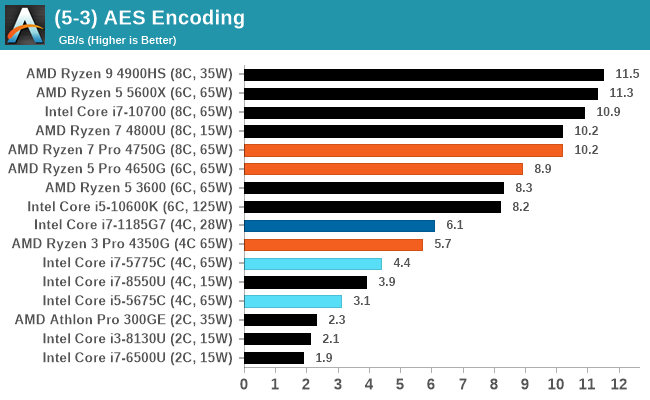
WinRAR 5.90: Link
For the 2020 test suite, we move to the latest version of WinRAR in our compression test. WinRAR in some quarters is more user friendly that 7-Zip, hence its inclusion. Rather than use a benchmark mode as we did with 7-Zip, here we take a set of files representative of a generic stack – a micture mixture of compressible and incompressible formats
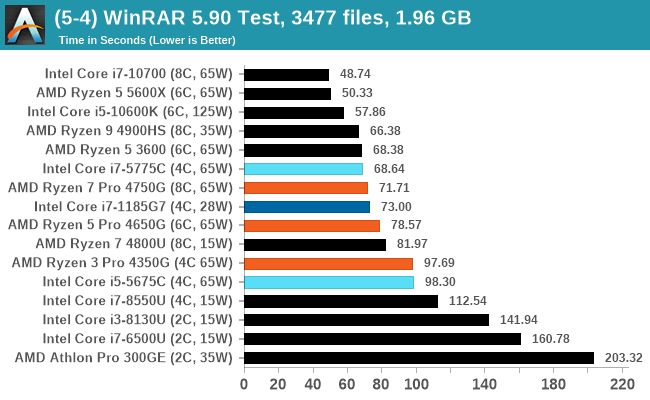
Mozilla Kraken 1.1
Kraken is a 2010 benchmark from Mozilla and does a series of JavaScript tests. These tests are a little more involved than previous tests, looking at artificial intelligence, audio manipulation, image manipulation, json parsing, and cryptographic functions. The benchmark starts with an initial download of data for the audio and imaging, and then runs through 10 times giving a timed result.
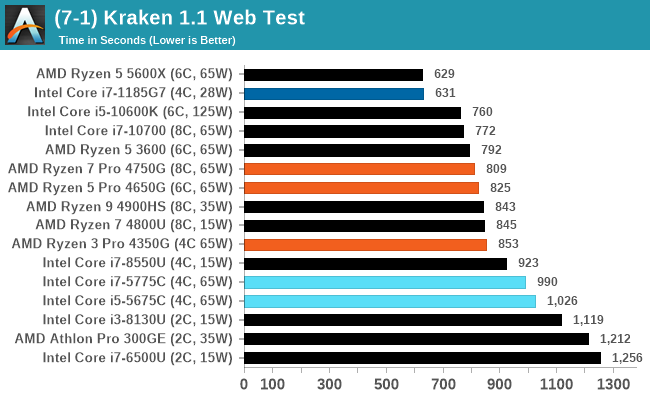
Google Octane 2.0
Our second web test is also JavaScript based, but uses a lot more variation of newer JS techniques, such as object-oriented programming, kernel simulation, object creation/destruction, garbage collection, array manipulations, compiler latency and code execution.

Speedometer 2: JavaScript Frameworks
Our newest web test is Speedometer 2, which is a test over a series of JavaScript frameworks to do three simple things: built a list, enable each item in the list, and remove the list. All the frameworks implement the same visual cues, but obviously apply them from different coding angles.
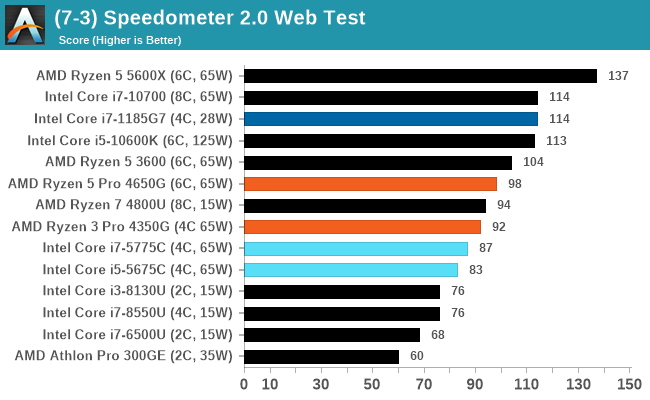










104 Comments
View All Comments
MDD1963 - Friday, December 18, 2020 - link
So, in a nutshell, this is still just a better CPU but still crippled with just over (barely) GT1030-level of integrated graphics...Assimilator87 - Friday, December 18, 2020 - link
To everyone complaining about the benchmark resolutions/settings: Just double the results of the 1080p benchmarks and that's the ballpark 720p performance. I'm sure 1080p max was used in order to make sure there was a complete GPU bottleneck. That's the only way to compare the GPUs in relation to each other. Once you have that scale, you can extrapolate to other resolutions.Ian, what happened to the Subor Z+ review? That would be such an incredibly interesting comparison point.
McFly323 - Friday, December 18, 2020 - link
The best World APU is PS5 AMD APU.But the AMD will never release that for PC buyers because that would murder PC components market.Oxford Guy - Friday, December 18, 2020 - link
Since these are OEM-only I wouldn't expect to see them married to high-performance RAM.Many are looking at this lineup from the point of view of the build-a-gaming-PC-myself enthusiast sector but one can also look at it from the point of view of "How much does slow OEM RAM hobble these APUs?" Since OEMS often tout the performance of products that don't perform as well as they could or should (a thing helped out by companies that sell stealth watered-down versions of their products, sometimes with the same name attached) it's useful to have the information out there about how they will perform with baseline RAM.
However, given that 3200 has been cheap for a long time (I got 16 GB for $90 in 2016 as I recall) it would be good to always have the tests show both the slow RAM and something affordable like 3200 that offers quite a bit more performance.
One problem that a company like AMD faces if making CPUs like this is the possibility of them being used with slow RAM. The way around that is to engineer the CPUs to fail to run with slow RAM.
Oxford Guy - Friday, December 18, 2020 - link
"The way around that is to engineer the CPUs to fail to run with slow RAM."So, not doing that means the company is satisfied with the parts being hobbled by slow RAM, not just the OEM.
vol.2 - Saturday, December 19, 2020 - link
If they make IGPU performance "deliver," it will eat into the sales of DGPUs.Valantar - Sunday, December 20, 2020 - link
It's great to see these reviewed! I bought a 4650G off a German ebay store a couple of months back, and I couldn't be happier with it for my HTPC. Sips power (I've never seen it exceed 110W at the wall), and performs admirably. With my Crucial Sport LT 3200C16 running happily at 3800C16 (1:1:1) (with near zero effort thanks to 1usmus' dram calc) and the iGPU at 2100 it delivers 60-75fps in Rocket League at 1080p Quality preset, which is perfectly enjoyable. I understand AT's choice of running JEDEC max spec DRAM, but for these chips in particular I think DRAM OC testing would be a good idea.artifex - Monday, December 21, 2020 - link
I feel let down by AMD that they won't officially put their better APUs out in the retail chain, when most AM4 boards out there have video connectors and associated hardware ready to support them. It's like a promise that can't be fulfilled.tkSteveFOX - Monday, December 21, 2020 - link
The Vega architecture and lack of DDR4X high speed RAM make AMD APU's just not worth it when you can get a 2600x and pair it with an RX5500 or GTX1650 or even an older 1050Ti and deliver 30-60% more gaming performance.With RDNA integrated, AMD could have blown away any Intel iGPU and lower end Nvidia solutions.
This 4th gen AMD Desktop APUs are simply not worth it.
Brane2 - Wednesday, December 23, 2020 - link
Isn't that a bit late now, that 5xxxx is to come out ?